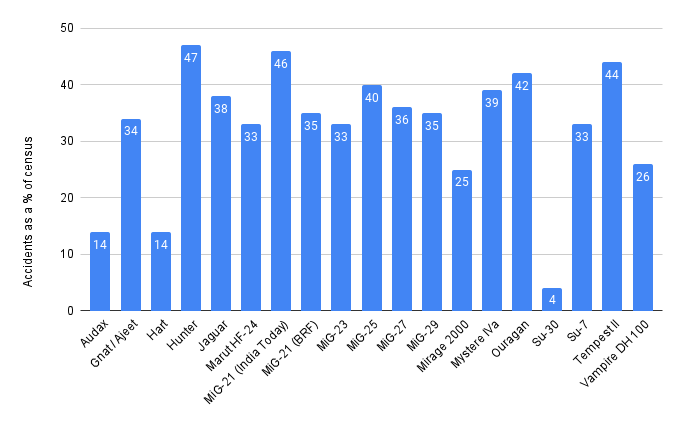TLDR: I think we need more empirical evidence than we have currently although there may be design choices that are apparent to someone with technical know-why that I don’t have.
The Indian news media comfortably describes the MiG-21, specifically and no other aircraft, as a “flying coffin”. It is a term used pejoratively for an aircraft that has a poor safety track record due to specific aspects of design and engineering. There are several reasons for which one may believe the MiG-21 has a poor safety record because of its vintage design.
Rajat Pandit writes in the Times of India
Without modern systems like FADEC (full authority digital electronic controls) and mission computers, the ageing MiG-21s also have the highest landing and take-off speed in the world at 340 mph.
He also attributes the poor safety record to issues not related to the design of the aircraft but
inadequate training to rookie pilots, shoddy maintenance and poor quality control of spares.
u/barath_s as adds that since it is a single engine aircraft, it does not have
[…] much backup in case of bird strike or fuel line manufacturing flaw.
Retired squadran leader and jaguar pilot Vijainder Kumar Thakur believes,
[…] the number of sorties flown has an impact on the accident rate. For every 200 flight hour, the MiG 21 likely logs double the number of landings as compared to Mirage, because of the MiG’s much lower endurance.
While there are many reasons one might consider it to be a safe candidate for being termed as a flying coffin, I think anyone studying this issue seriously should be asking two questions: 1) Is there any empirical basis to believe that MiG-21’s accident frequency is higher than other aircraft in IAF’s fleet? 2) How many of MiG-21’s excess accidents when compared with other aircraft in IAF’s fleet are not explained by confounding factors like their aggregate flying hours, flight conditions, differential training/maintenance/spare part quality or due to some unexplainable reason other than the design (random variation)?
I did some calculations on some not-so-reliable numbers to find out accident rate of IAF’s fleet. I sourced data mainly from Bharat Rakshak’s database (accidents, census) but also from Wikipedia (historical, active) and a couple of other secondary sources (India Today and WION). Here is the spreadsheet with all figures and corresponding sources. These charts illustrate some of the results:

It should be pretty obvious that one shouldn’t compare aircraft by their raw accident numbers since they contribute to the IAF fleet in different proportions. So the next obvious number to look at would be the census (present and historical) of each of these aircrafts in IAF.

It’s clear that those aircraft which had more accidents also form a larger part of IAF’s fleet. To know by how much, we can find what percentage are accidents of their census.

MiG-21’s accident rate, considering India Today’s accident figure, puts it significantly higher than other MiGs and also the Mirage 2000 for sure, 15 to 39% higher than other MiGs and 84% higher than Mirage 2000, while if I consider BRF’s it is -6 to 13% higher than other MiGs and 40% higher than the Mirage 2000 (so not that different from other MiGs per BRF’s). But something more important to note here is that the last chart, which plots accident rate, is much more flatter than the first one, which plotted number of accidents. It is also interesting to note that such discrepancies exist among other aircrafts too. For example, it seems that the Su-30 has similar number of accidents (11) as the Mirage 2000 (13), even though IAF has 5 times Su-30s as Mirage 2000s. Moreover, if someone was being honest they would call the entire fleet of IAF a flying coffin except Su-30.
There are several other confounding factors that I listed earlier for which data in unavailable and so can’t be used to adjust the accident rate or be privy to the entire context. Amongst the factors I listed earlier, aggregate flying hours and flight conditions would not be available due to security reasons possibly (or some other reason I’m not aware of) and differential training/maintenance/spare part quality is not quantifiable. In the absence of this, in my view, vital information, I believe it would be 1) inappropriate to conclude that there are empirical reasons to believe that MiG-21’s higher accident rate is due to its vintage design even though there may be theoretical reasons to believe that and 2) impossible to find out how many of those excess accidents are attributable to its design. However, it is clear that most of MiG-21’s accidents can be explained by the fact that it contributes more to IAFs fleet: 25% of Mirage 2000s and 35% of MiG-29s have ended up in accidents while this figure for MiG-21s sits at 46%, considering India Today’s accident figure (which is more recent), and 35%, considering BRF’s. All other aircraft except Su-30, Hart and Audax are also in that range.